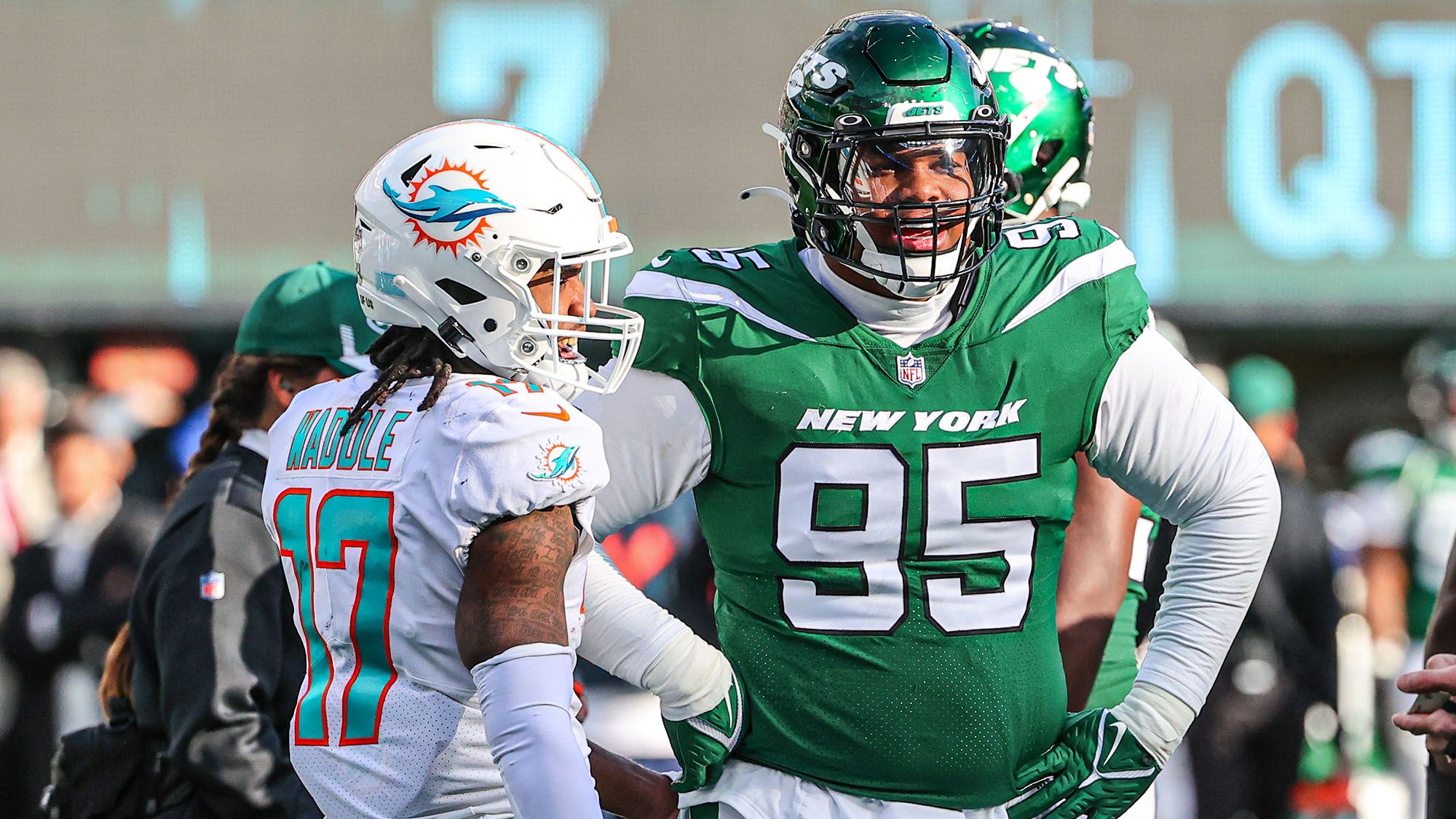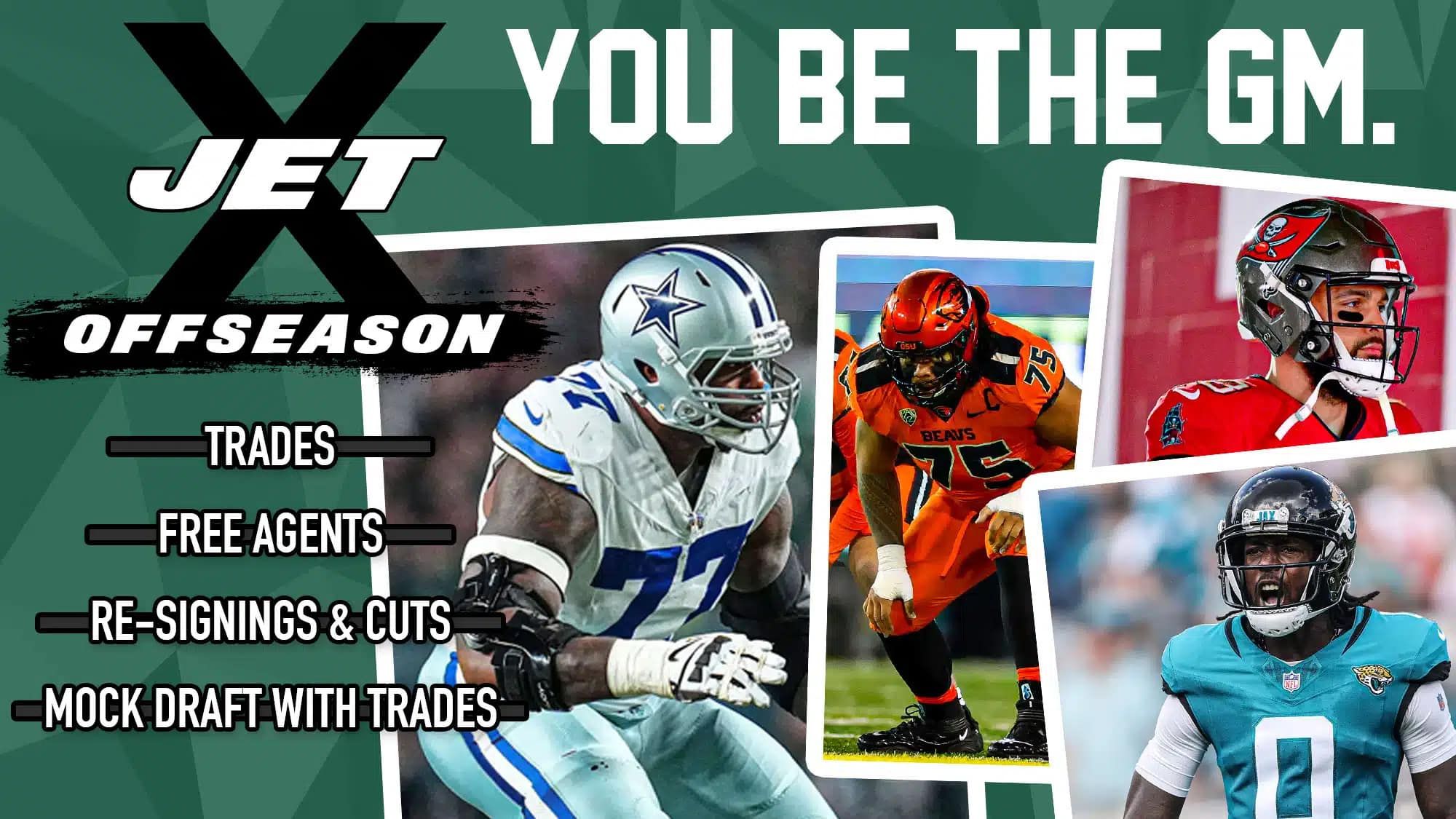Quinnen Williams’ true ranking among NFL defensive tackles makes things interesting for the New York Jets
Quinnen Williams is a polarizing player among New York Jets fans. Some see him as a bona fide star at the defensive tackle position. Others see him as a merely decent player who is a disappointment relative to his status as a top-three draft pick.
Where does Williams actually rank among all defensive tackles in the NFL?
Let’s dive into Williams’ production in the 2021 season and see where he stacked up at his position.
Quinnen Williams’ overall 2021 production
One metric that serves as a good starting point when attempting to rank a player at his position is his overall grade at Pro Football Focus. It’s a subjective metric (based on the grading of a player’s performance on every snap), so it is hardly an end-all-be-all, but it’s worth taking into account as at least one piece of the puzzle when estimating a player’s impact.
Williams earned an overall grade of 64.4 at PFF this season. That placed him 37th out of the 89 interior defensive linemen (IDL) who played at least 400 defensive snaps.
That makes him a top-half player, but Williams is capable of much more than that.
Fortunately, Williams’ overall PFF grade is his worst metric out of any that we will see in this study. He ranks far more favorably in every other category we will look at.
Next up, we will look at where Williams ranks at his position when it comes to his raw playmaking production. Quite simply, how many tangible, trackable plays does he make relative to his peers?
To estimate the overall playmaking impact of every IDL, I combined each player’s totals in the following three categories: pressures, stops, and pass breakups. We’ll call this cumulative stat “impact plays”.
A player’s pressure total tells us about his pass-rushing impact. Pressure totals are comprised of sacks, quarterback hits, and quarterback hurries.
A player’ stop total tells us about his ability to find the ball and finish crucial tackles. Stops are any tackles on plays that hold the offense to a poor result. They can happen on either run or pass plays. The stat also includes sacks, which are also counted as pressures, so for the purpose of this study, I subtracted each player’s sack total from their stop total to avoid double-counting sacks. Thus, the stat is mostly comprised of stops against the run.
Pass breakups are rare for IDL, but they are certainly impactful plays, so they are worth including here. They make up a very small portion of this stat, though – pressures and stops make up the majority of the pie.
Williams had 34 pressures, 35 stops, and three pass breakups in 2021. Subtract his seven sacks (he officially had 6.0, but two were half-sacks, so he contributed to 7 total) to avoid double-counting them, and we come to a final mark of 65 impact plays for Williams.
That number ranked as the 17th-best total of impact plays among IDL.
To account for injuries and measure all players on the same plane, it’s fair to look at things on a per-game basis rather than a total volume basis.
Williams missed two games in 2021, making 15 appearances, so he averaged 4.3 impact plays per game. That ranked 12th at his position among qualifiers.
Here are the top-15 IDL of 2021 when it comes to impact plays per game (among 89 players with 400+ snaps played):
- Aaron Donald, LAR (7.3)
- Cameron Heyward, PIT (6.1)
- Jeffery Simmons, TEN (5.8)
- Chris Jones, KC (5.6)
- Kenny Clark, GB (5.6)
- Javon Hargrave, PHI (5.4)
- Jonathan Allen, WAS (5.2)
- Daron Payne, WAS (4.8)
- Dexter Lawrence, NYG (4.6)
- Arik Armstead, SF (4.5)
- Leonard Williams, NYG (4.5)
- Quinnen Williams, NYJ (4.3)
- Christian Wilkins, MIA (4.3)
- Christian Barmore, NE (4.3)
- Roy Robertson-Harris, JAX (4.2)
Williams ranked sixth among IDL with 2.3 stops per game and 25th with 2.3 pressures per game. He was 10th in total stops (35) and 28th in total pressures (34).
Quinnen Williams’ per-snap 2021 production
If you want to get even more specific than per-game production, we can look at things on a per-snap basis. That way, every IDL from the league’s most heavily-used workhorses (Aaron Donald and Cameron Heyward) to the rotational players (like Foley Fatukasi) can be compared fairly.
Let’s first look at Williams’ specific performance in the passing game and the run game before moving on to his overall per-snap rankings.
As a pass rusher, Williams created 34 pressures (28th) while rushing the passer on 361 snaps (42nd). That gives him a pressure rate of 9.4%, which ranked 21st out of 89 qualifiers.
Williams picked up 25 stops against the run (17th) while playing 249 snaps against the run (46th). That gives him a run-stop rate of 10.0%, ranking 13th out of 89.
Now, let’s look at Williams’ overall production on a per-play level.
Williams produced 65 impact plays (17th) while ranking 48th in defensive snaps with 613. This means he produced an impact play once every 9.4 snaps on average. That mark ranked 12th out of 89 qualifiers.
Here are the top-15 IDL of 2021 when it comes to making impact plays on a per-snap basis, sorted by snaps per impact play (among 89 players with 400+ snaps played):
- Chris Jones, KC (8.1)
- Christian Barmore, NE (8.2)
- Zach Sieler, MIA (8.2)
- Aaron Donald, LAR (8.4)
- Javon Hargrave, PHI (8.5)
- Jonathan Allen, WAS (8.7)
- Kenny Clark, GB (8.8)
- Cameron Heyward, PIT (9.2)
- Roy Robertson-Harris, JAX (9.3)
- Ed Oliver, BUF (9.3)
- Jeffery Simmons, TEN (9.4)
- Quinnen Williams, NYJ (9.4)
- Vita Vea, TB (9.7)
- D.J. Jones, SF (9.8)
- David Onyemata, NO (10.0)
So, where did Quinnen Williams rank in 2021?
Taking all of these metrics into account, I think it’s fair to say that Williams ranked somewhere in the top 12-15 range among IDL.
It’s tough to make an argument that Williams was a top-10 guy. Even when you adjust things to a per-game and a per-snap level, the evidence simply isn’t there.
However, it’s also hard to argue that Williams wasn’t a top-15 guy. At the absolute worst, there is no way to say he was not top-20.
Considering that we’re comparing against nearly 90 other players, a top-15 ranking would still make Williams a very good player – just not quite the all-world player that he has shown he is capable of being.
So, Williams had a strong year even if it fell short of expectations, but it was disappointing for this reason: It’s not as if we’re still hoping to one day see Williams become a top-5 player at his position. Williams already was a top-5 player at his position in 2020.
The 2021 season was a decline for him.
In 2020, Quinnen Williams was a star
Williams’ 2021 season was supposed to be his leap forward from “great” to “dominant”, but instead, it was a sizable step backward compared to an outstanding 2020 season.
In many of the metrics we looked at above, Williams was already a top 5-10 player at his position in 2020.
Here is a comparison of Williams’ performance over the last two seasons in a few of the metrics we’ve studied:
- Overall PFF grade: 81.4 in 2020 (10th), 64.4 in 2021 (37th)
- Impact plays per game: 5.5 in 2020 (4th), 4.3 in 2021 (12th)
- Snaps per impact play: 8.2 in 2020 (2nd), 9.4 in 2021 (12th)
Williams had 72 impact plays in 2020, eight more than he had in 2021 despite playing two fewer games and 26 fewer defensive snaps.
When it came to impact plays per game, Williams’ mark of 5.5 trailed only Cameron Heyward (5.9), Stephon Tuitt (6.3), and Aaron Donald (7.1). On a per-play basis, Williams’ average of 8.2 snaps per impact play trailed only Donald (7.7) among qualified IDL.
Yes, Williams was that good in his second year.
Williams experienced significant dips in both phases of the game. Check out his declines as a pass rusher (pressures per game, pressure rate) and run stopper (run stops per game, run-stop rate):
- Pressures per game: 3.0 in 2020 (12th), 2.3 in 2021 (25th)
- Pressure rate: 10.3% in 2020 (13th), 9.4% in 2021 (21st)
- Run stops per game: 2.2 in 2020 (1st), 1.7 in 2021 (15th)
- Run-stop rate: 13.6% in 2020 (2nd), 10.0% in 2021 (14th)
Quinnen Williams must establish consistency to earn a lucrative contract
We are rapidly approaching the point where contract negotiations will begin between Williams and the Jets. New York must make a decision on Williams’ fifth-year option for the 2023 season by May 3 of this year, which should be a no-brainer to accept. Once that becomes official, Williams’ future will be a constant topic of discussion.
For New York to make an informed decision on how to handle negotiations with Williams, the team needs to know exactly what caliber of a player they are dealing with.
Play: 👉 the Jet X Offseason Simulator
Right now, it is hard to definitively say where Williams stacks up at his position. He’s been so hot-and-cold that it is tough to deduce what the Jets would be paying for.
If Williams is the guy that his 2020 numbers say he is, then the Jets should feel comfortable paying just about whatever it takes to keep him around long-term.
But if Williams is the guy that his 2021 numbers say he is, would the Jets really be getting their money’s worth on a deal that would likely cost them north of $70 million?
Making matters even more difficult is the fact that Williams is so erratic in-season. Not only are his 2020 and 2021 numbers quite different, but he experienced drastic production changes within each of those two campaigns – especially in the passing game.
Six games into the 2020 season, Williams still hadn’t found his groove as a pass rusher yet. He was averaging 1.3 pressures per game on a 5.4% pressure rate, even posting two zero-pressure games.
After that, Williams became a monster, averaging 4.4 pressures per game over his last seven games. His pressure rate leaped to 13.4%.
Williams carried over that momentum into the start of the 2021 season. Through six games, he was flying high, racking up 20 pressures as he ranked second among IDL in pressure rate (12.7%) and seventh in pressures per game (3.3).
A steep decline followed. Williams collected only 14 pressures over the next nine games, averaging 1.6 pressures per game on a 6.9% pressure rate.
Williams has been fairly steady in the run game, but the volatility of his pass-rushing performance is incredible.
For a 13-game run from mid-2020 to mid-2021, Williams was getting after the quarterback like prime Fletcher Cox. Yet, over a 15-game sample that includes early-2020 and late-2021, he was producing at a mediocre level that could be matched by a replacement-level player.
Williams himself acknowledged this phenomenon in his final press conference to close the 2021 season.
“I’m not near where I want to be, when it come down to the production or the player I want to be,” Williams said. “I have games where I make big plays, and different stuff like that, and I have games where I just do my job and [I’m] an above-average defensive tackle in the league.
“But I got to be able to be a person where I can dominate and take over football games; such as like Aaron Donald, Fletcher Cox, and those guys; on that elite level where they can take over football games. I feel like I have that ability also and I got to tap into a new level this offseason to become that player I know I can be and the organization needs me to be.”
The Jets need Williams to have a consistent season in 2022 to make their contract decision easier. Whether that means he fulfills his potential as a top-5 star or he settles in as a solid top-20 player, the Jets just need Williams to provide a clear definition of who he is.
If Williams’ roller-coaster tendencies continue, Joe Douglas and the Jets will be faced with an incredibly difficult decision to make – one that could either pay tremendous dividends or blow up in their faces.



